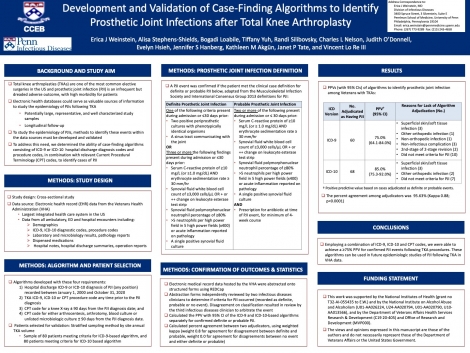Erica Weinstein
Development and Validation of Case-Finding Algorithms to Identify Prosthetic Joint Infections After Total Knee Arthroplasty
Abstract
Purpose: To determine the positive predictive values (PPVs) of ICD-9 and ICD-10- based diagnostic coding algorithms to identify prosthetic joint infection (PJI) following knee arthroplasty (TKA) within the United States Veterans Health Administration .
Methods: We identified patients with: 1) ICD-9 or ICD-10 diagnosis codes for PJI, 2) ICD-9 or ICD-10 procedure code for TKA prior to PJI diagnosis, 3) Current Procedural Terminology (CPT) code for knee X-ray within +/-90 days of the PJI diagnosis, and 4) at least 1 CPT code for arthrocentesis, arthrotomy, blood culture, or microbiologic procedure within +/-90 days of the PJI diagnosis. Separate samples of patients identified with the ICD-9 and ICD-10 PJI diagnoses were obtained, stratified by TKA procedure volume at each medical center. Medical records of sampled patients were abstracted and reviewed by infectious disease clinicians to adjudicate PJI events. The PPV (95% confidence interval [CI]) for the ICD-9 and ICD-10 PJI algorithms were calculated.
Results: Among a sample of 80 patients meeting the ICD-9-CM PJI algorithm, 60 (PPV 75.0%, [CI 64.1-84.0%]) had confirmed PJIs. Among a sample of 80 patients who met the ICD-10-CM PJI algorithm, 68 (PPV 85.0%, [CI 75.3-92.0%]) had a confirmed diagnosis.
Conclusions: An algorithm requiring an ICD-9-CM or ICD-10-CM code for PJI following an ICD-9-CM or ICD-10-PCS diagnosis for TKA, combined with CPT codes, had a PPV of 75% and 85%, respectively, for confirmed events and could be considered for use within epidemiologic studies.
Keywords
total knee arthroplasty; prosthetic joint infection; epidemiologic methods; veteran; outcomes; validation studiesCommenting is now closed.
About Us
To understand health and disease today, we need new thinking and novel science —the kind we create when multiple disciplines work together from the ground up. That is why this department has put forward a bold vision in population-health science: a single academic home for biostatistics, epidemiology and informatics.
© 2023 Trustees of the University of Pennsylvania. All rights reserved.. | Disclaimer


